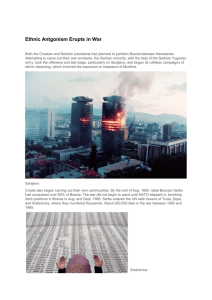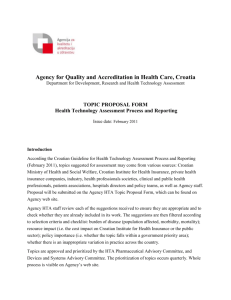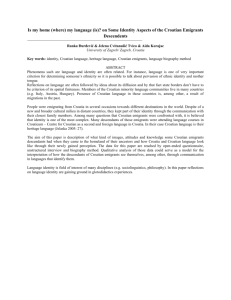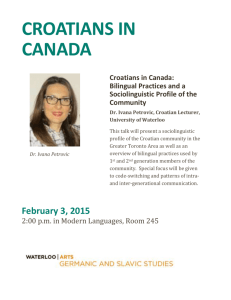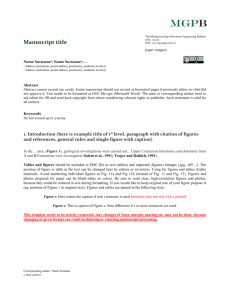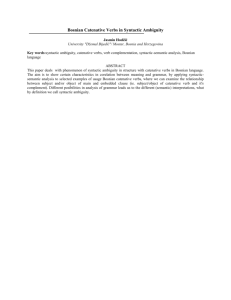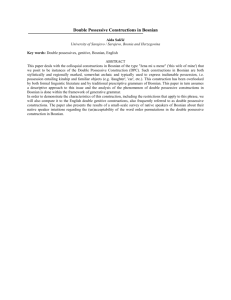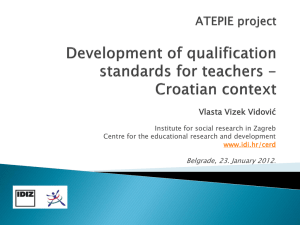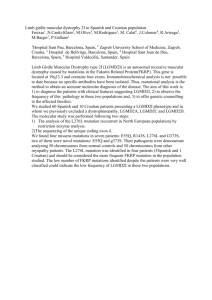Bosnian, Croatian, Serbian: A Textbook with Exercises and Basic
advertisement
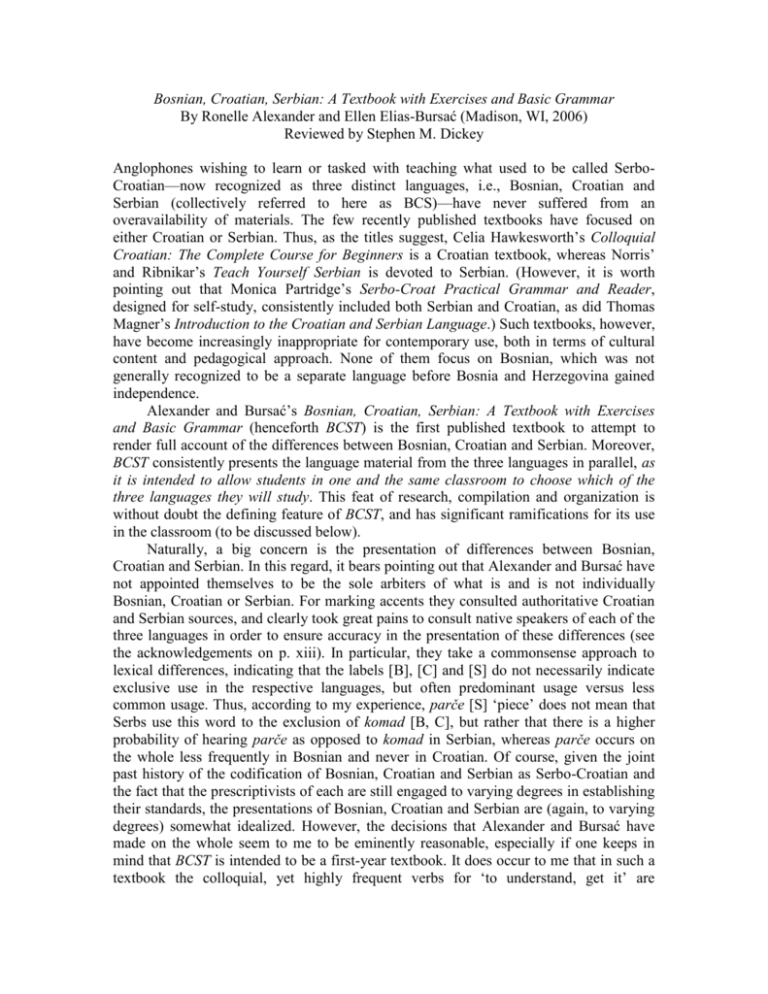
Bosnian, Croatian, Serbian: A Textbook with Exercises and Basic Grammar By Ronelle Alexander and Ellen Elias-Bursać (Madison, WI, 2006) Reviewed by Stephen M. Dickey Anglophones wishing to learn or tasked with teaching what used to be called SerboCroatian—now recognized as three distinct languages, i.e., Bosnian, Croatian and Serbian (collectively referred to here as BCS)—have never suffered from an overavailability of materials. The few recently published textbooks have focused on either Croatian or Serbian. Thus, as the titles suggest, Celia Hawkesworth’s Colloquial Croatian: The Complete Course for Beginners is a Croatian textbook, whereas Norris’ and Ribnikar’s Teach Yourself Serbian is devoted to Serbian. (However, it is worth pointing out that Monica Partridge’s Serbo-Croat Practical Grammar and Reader, designed for self-study, consistently included both Serbian and Croatian, as did Thomas Magner’s Introduction to the Croatian and Serbian Language.) Such textbooks, however, have become increasingly inappropriate for contemporary use, both in terms of cultural content and pedagogical approach. None of them focus on Bosnian, which was not generally recognized to be a separate language before Bosnia and Herzegovina gained independence. Alexander and Bursać’s Bosnian, Croatian, Serbian: A Textbook with Exercises and Basic Grammar (henceforth BCST) is the first published textbook to attempt to render full account of the differences between Bosnian, Croatian and Serbian. Moreover, BCST consistently presents the language material from the three languages in parallel, as it is intended to allow students in one and the same classroom to choose which of the three languages they will study. This feat of research, compilation and organization is without doubt the defining feature of BCST, and has significant ramifications for its use in the classroom (to be discussed below). Naturally, a big concern is the presentation of differences between Bosnian, Croatian and Serbian. In this regard, it bears pointing out that Alexander and Bursać have not appointed themselves to be the sole arbiters of what is and is not individually Bosnian, Croatian or Serbian. For marking accents they consulted authoritative Croatian and Serbian sources, and clearly took great pains to consult native speakers of each of the three languages in order to ensure accuracy in the presentation of these differences (see the acknowledgements on p. xiii). In particular, they take a commonsense approach to lexical differences, indicating that the labels [B], [C] and [S] do not necessarily indicate exclusive use in the respective languages, but often predominant usage versus less common usage. Thus, according to my experience, parče [S] ‘piece’ does not mean that Serbs use this word to the exclusion of komad [B, C], but rather that there is a higher probability of hearing parče as opposed to komad in Serbian, whereas parče occurs on the whole less frequently in Bosnian and never in Croatian. Of course, given the joint past history of the codification of Bosnian, Croatian and Serbian as Serbo-Croatian and the fact that the prescriptivists of each are still engaged to varying degrees in establishing their standards, the presentations of Bosnian, Croatian and Serbian are (again, to varying degrees) somewhat idealized. However, the decisions that Alexander and Bursać have made on the whole seem to me to be eminently reasonable, especially if one keeps in mind that BCST is intended to be a first-year textbook. It does occur to me that in such a textbook the colloquial, yet highly frequent verbs for ‘to understand, get it’ are conspicuously absent: kontati/skontati [B], kužiti/skužiti [C] and kapirati/ukapirati [S].1 Perhaps they were considered too slangy for a first-year textbook, but since various slangy items such as vozdra (šatrovački for zdravo ‘hello’) are included, I see no reason to omit these important verbs. BCST is designed to be used with audio recordings that come in three sets of CDs (entitled Bosnian, Croatian, Serbian Audio Supplement), one for Bosnian, one for Croatian, and one for Serbian. The CDs do not come with the textbook, but must be ordered separately. BCST is also designed to be used with Alexander’s concurrently published Bosnian, Croatian and Serbian, a Grammar with Sociolinguistic Commentary (BCSG); the grammatical explanations in BCST always include a boldface number referencing the section of BCSG more fully treating a given grammatical topic. As BCST may be used alone and in any case deserves its own share of attention, I have decided to devote this review to it alone (a review of Bosnian, Croatian and Serbian, a Grammar with Sociolinguistic Commentary will follow in the next issue of SlavFile). BCST is organized into 20 lessons. The lessons each consist of three parts, neatly organized as “A”, “B” and “C”. The “A” section consists of the model material, such as dialogues and texts, which are accompanied by vocabulary lists and short grammatical explanations. This is followed by the in-class drills of the “B” section, which are in turn followed by the homework assignments of the “C” section. Instructors should be aware that, with the exception of lessons 15–19 and 20 (the latter of which has a short story divided into 8 parts), all lessons each “A” section contains four subsections “A1–4”, each with vocabulary, dialogues/texts and grammar points, so that completing the twenty lessons is, as the authors suggest, appropriate for two or more likely three semesters of coursework. The “A” sections of lessons 1–14 are organized around simple dialogues and short narrative or informative texts, including instructions for making Turkish coffee in lesson 14; lesson 15 focuses on a Croatian cartoon, Pingvin Čarli (‘Charlie the Penguin’), which is included on a DVD in the back cover; lessons 16–18 focus on poetry, (three Bosnian poems are presented in lesson 16, three Croatian poems in lesson 17, and two Serbian poems and one Montenegrin folk poem in lesson 18); lesson 19 focuses on letter writing, and lesson 20 concludes with the short story U zagrljaju rijeke (‘In the River’s Embrace’) by Croatian writer Miro Gavran. The “B” sections contain drills, which consist largely of replacement drills— sentences and dialogues containing certain elements that are to be replaced or blanks that are to be filled in—as well as questions to be answered. The “C” sections contain the homework assignments, which consist of sentences for translation in both directions, fillin-the-blanks exercises, matching exercises, etc. The homework sections in lessons 7–14 also include short reading exercises based on the aphorisms of Serbian humorist Dušan Radović (all written in Cyrillic) for which the students are required to compose questions; the homework sections in lessons 4–11 each include one of the simple Osam malih priča o mojoj ženi (Eight Short Tales about My Wife) by Serbian writer David Albahari; the homework sections in lessons 12–19 each include a part of the short story Ljubav na španjolski način (Love, Spanish Style) by Bosnian writer Muharem Bazdulj. The “C” sections of the first six units also include geography questions and labeled maps of 1 The Bosnian imperfective kontati also has a common conative meaning ‘to try to figure out’. Bosnia and Herzegovina and Croatia, which are very useful, though for some reason a map of Serbia and Montenegro is missing. In addition to the core lessons, BCST contains a map of the lands of the former Yugoslavia in BCS on the flyleaf, as well as 10 appendices that contain a great deal of useful material: (1) the Latin and Cyrillic alphabets; (2) a selection of typical Bosnian, Croatian, and Serbian male and female names; (3) samples of Cyrillic handwriting, including a scans of actual Cyrillic handwriting and not merely italicized font; (4) tables of nominal declension, including declensions of nouns, adjectives, pronouns and personal names; (5) a list of common prepositions, alphabetically and by case; (6) tables of verbal conjugation; (7) Osam malih priča o mojoj ženi (Eight short tales about my wife,—a series of eight very short texts about a man and his wife by the Serbian writer David Albahari); (8) Ljubav na španjolski način (Love, Spanish Style—a short story in eight installments of a little under a page each by the Bosnian writer Muharem Bazdulj); (9) translations of the material in the “A” sections of lessons 1–14; (10) a table of contents of the audio recordings (which are not included). BCST also contains BCS—English and English—BCS glossaries that include grammatical information and account fully for the lexical differences discussed above. The grammar is presented in lessons 1–15; lessons 16–20 function more as reading selections. The devotion of three full lessons (16–18) to poetry, in addition to the prose selections (two of which, those of Albahari and Bazdulj, were written especially for BCST), lends BCST a rather belletristic character; one wonders whether such an emphasis on poetry will play well with the majority of contemporary undergraduate students, for whom BCST is presumably marketed. In this regard, however, it should be pointed out that various aspects of ordinary material culture occur throughout the textbook, including parallel black-and-white photographs of various locations and objects and a myriad of cultural facts, so that the cultural focus offers plenty for first-year students of varying interests. The focus on the parallel presentation of Bosnian, Croatian and Serbian combined with the emphasis on literary selections seems to have absorbed Alexander and Bursać’s energies and precluded the inclusion of communicative problem-solving tasks, of which there are almost none as far as I could tell. For instance, though lesson 13 contains a dialogue in which a guest is served by a host, nowhere is there provided the necessary scaffolding for students to act out a scenario of ordering in a restaurant or café. (Given the emphasis on the parallel presentation of Bosnian, Croatian and Serbian, it would have been desirable to include either fabricated or scanned restaurant/café menus from each country to allow students to act out ordering in a restaurant; instructors with fewer resources than Alexander and Bursać will likely find it a task to procure such materials from all three countries themselves.) Likewise, despite the photographs of bus and trams tickets on p. 99, no scaffolding is provided for acting out the purchasing of bus or train tickets. Nor, in fact, is there scaffolding given to coach students in purchasing and service encounters in general, despite the inclusion of narratives about shopping on pp. 182–3. There are dialogues on pp. 204–5 that are well-suited to serve as models for activities of asking for directions, but it is left to the instructor to provide maps which would facilitate such activities by students working in pairs. To sum up, it is fair to say that BCST relies by and large on mechanical replacement drills, and that its lack of basic problem-solving tasks for students, which have become the sine qua non of foreign-language teaching pedagogy, will probably be seen to be its greatest drawback. The presentation of the grammar itself is generally adequate, and here it should be pointed out again that BCST is intended to be used with Alexander’s BCSG. Nevertheless, some comments on the organization and order of presentation of the grammar are in order. The morphology and functions of the seven cases are presented in the first 8 lessons. If we make the conservative (but in my opinion realistic) assumption that each lesson requires about two weeks of classroom time, this means that the case system is covered in the first semester. A plus is that the basic syntax of numbers is presented in lesson five along with other functions of the genitive, i.e., in the first semester, which is desirable as counting/quantification is a basic communicative task and one that should be introduced as early as possible. Basic tense categories follow quickly—the future tense in lesson 9 and a full account of the past tense in lesson 10. The aorist and imperfect are introduced in lesson 12 and repeated in lesson 16, and the inclusion of these otherwise rare forms is necessitated only by the poetry selections in lessons 16–18. Other grammatical categories are introduced in a more piecemeal fashion. Verbal aspect, one of the most difficult grammatical features of Slavic languages, is covered in brief commentaries in lessons 2, 5, 7, 9, 10 and 15. There is no easy way to teach or learn Slavic aspect despite its binary nature, and since aspect in BCS is relatively easy to learn relative to other languages such as Russian, the approach to aspect offered here seems reasonable. The concentric approach to aspectual issues, culminating with the commentary on aspect and narrative structure in lesson 15, is probably more productive than trying to pack aspect into one or two lessons. As far as the grammatical explanation itself is concerned, labeling the actual present Pišeš li pismo? ‘Are you writing a letter?’ as “general” in the table on p. 145 is unfortunate, as there is nothing demonstrably “general” in the usage of imperfective present-tense forms for the actual present. In the accompanying explanation no use is made of this term, rather, such usage is discussed in terms of “an action in progress” so that this term almost appears to be erroneously placed. (In Slavic aspectology the term “general” is more often associated with generic utterances such as Poštari donose poštu ‘Mailmen bring the mail’ or with certain kinds of past-tense imperfective statements.) With some other grammatical categories, it is harder to understand why the explanations are broken up. For instance, the relative pronoun koji (for some reason called a “relative conjunction”) and relative clauses are explained in two segments on pp. 180 and 206, despite the fact that they cannot be usefully discussed in isolation from one another—relative pronouns do not occur outside of relative clauses and relative clauses do not (in BCS) occur without a relative pronoun. Instructors will likely find themselves forced to give a single, comprehensive explanation of relative pronouns and relative clauses the first time the issue arises in lesson 12. Likewise, the “future exact” (second future) is introduced in lesson 12 prior to the discussion of conditional sentences, although in the standard languages it occurs almost solely in one kind of conditional sentence. Conditional sentences are introduced only in the following lesson (13) along with forms of the conditional mood. Again, instructors should expect difficulties in introducing this material piecemeal, particularly since the proper use of conditional sentences is one of the most difficult areas of grammar for students of BCS to master. Perhaps a comprehensive treatment can be provided by the corresponding sections of BCSG as background reading, but past experience tells me that in the end a considerable amount of class time will be necessary to give a comprehensive explanation of the system of conditional sentences. It should also be pointed out here that the explanation provided in BCST alone is inadequate: BCSG or some other grammatical treatment must be referred to. Instructors should be prepared for a relatively high concentration of difficult grammar in lessons 12 and 13: relative clauses, the “future exact”, the conditional mood, conditional sentences, purpose clauses and modal uses of the conjunction da ‘that’, to name the main topics. Such concentrations are probably unavoidable in a textbook attempting to cover all the major structures of a grammatical system. If an instructor has three semesters to cover this textbook, most of the aforementioned grammatical material in lessons 12 and 13 as well as the voice issues in lesson 14 are probably best left for early in the third semester, depending on how thoroughly the material is to be learned. Otherwise it will probably come up late in the second (spring) semester, when the students’ energy is waning. Let us now turn to issues involved with the philosophical approach of including Bosnian, Croatian and Serbian as separate entities in a single textbook. The suggestion on p. xi of the preface that, whereas in the past one could simply learn Serbo-Croatian, one must now “choose which of the three successor languages” s/he wishes to learn, i.e., Bosnian, Croatian or Serbian, is only partially true. Those who learned “Serbo-Croatian” before the breakup always had to stick consistently either to Croatian or Serbian anyway, or else be constantly corrected by native speakers. Thus, this textbook, which presents itself as a consequence of the breakup, would in my opinion have been just as helpful and appropriate while Serbo-Croatian still existed de jure. It seems to me that there are three main ways in which BCST can be used: (1) for self-study, without an instructor; (2) by an instructor offering the individual students the choice of learning Bosnian, Croatian or Serbian; (3) by an instructor who nevertheless sticks with a single language for the entire group of students. These possibilities are discussed in order. Apart from the fact that some in-depth grammatical explanations must be obtained from BCSG or elsewhere, BCST is ideal for someone learning BCS without an instructor, as the focus on the relationship between (and, if you will, side-by-side existence of) Bosnian, Croatian and Serbian contained in BCST allows an independent learner quick access and constant exposure to the similarities and differences between them, something that is unavailable from other textbooks, and obtainable only with difficulty from other sources. In my opinion, BCST is a must for someone learning BCS independently. As for the use of BCST to offer the choice of Bosnian, Croatian or Serbian to individual students in a single classroom, there are several issues that complicate the picture. First, there are not only few anglophone speakers of BCS, but also few native speakers of Bosnian, Croatian or Serbian who are sufficiently fluent in all three vernaculars as to be able to teach them with the ease needed in a single classroom. My suspicion is that only a native speaker with considerable experience in Bosnia, Croatia and Serbia could do this effectively, especially after the first year. (In this respect, it should be kept in mind that the questions posed by students will always exceed the boundaries of the information contained in the textbook.) But even then, there is the potentially very tricky issue of exactly how the classroom should be conducted, i.e., in one language, or two or three? It seems to me that for purposes of saving time the instructor will be forced to speak only Bosnian, Croatian or Serbian, which then raises its own set of problems. In general, it will be relatively easy for students to keep to their chosen language when reciting dialogues provided in the textbook, but I suspect that it will be much harder for them to keep things straight when composing their own dialogues together in class. Another issue is that of program curriculum: if a BCS program includes two or three years of language instruction, what happens in subsequent semesters after the completion of BCST? Producing comparable materials at a higher level would be an enormous task, one that I do not think most instructors have the time or resources to engage in while teaching at the same time. The only alternative is to offer the students the choice between Bosnian, Croatian and Serbian in the first two or three semesters, and to restrict them all to one or the other in subsequent semesters. That approach will probably not sell well with students to begin with, and will also encounter problems with those required to switch, say, from Serbian to Croatian in the fourth or fifth semester. Unfortunately, Alexander and Bursać offer no teacher’s aids, instructions or suggestions on how to go about managing such a classroom or dealing with issues of curriculum, something that is fair to expect from a textbook that is designed to allow students the choice between Bosnian, Croatian and Serbian. Instructors should consider carefully how they will manage the classroom should they use BCST as intended. I myself would have reservations about doing so for the reasons discussed above, despite of the fact that I have spoken both Serbian and Croatian at various times and can switch when I consider it appropriate. The third possibility, using BCST to teach all students either Bosnian, Croatian or Serbian, seems to me to be perhaps the most immediately useful application of the textbook. Using BCST in this way would avoid the problems discussed above involved with teaching the different languages simultaneously, while also keeping the students constantly aware (due to the format, if nothing else) of the similarities and differences between the Bosnian, Croatian and Serbian. If ijekavian is to be taught, another possibility is to let students choose between Bosnian and Croatian, as the differences between these two ijekavian languages on the whole present fewer problems than those between Bosnian or Croatian and Serbian. In any case, I think that using this textbook to teach a single language is not a bad option, especially for the first use of the textbook by an instructor, as BCST has the advantage of constantly reminding students of the differences between these genetically related and similar languages. To conclude, BCST contains an impressive course of materials for those wishing to learn and teach BCS, and is strikingly innovative in its consistent presentation of Bosnian, Croatian and Serbian in a side-by-side manner. The linguistic accuracy of Alexander and Bursać’s presentation is good, and more than adequate for a first-year textbook. It includes a great deal of cultural information in the lessons, probably more than any textbook I am aware of, as well as numerous black-and-white photographs from Belgrade, Sarajevo and Zagreb. The editing is excellent (the one obvious omission I noticed is that in the list of names on p. 317 Hajrùdin should be marked as [B]). The grammar explanations, while generally good, are not always sufficiently complete to stand alone, and additional explanations must be taken either from BCSG or some other source. The main drawback is the lack of structured problem-solving tasks (ordering in a restaurant, purchases, etc.), which instructors will have to add using their own materials. It is likely that many instructors will think twice before jumping in and using BCST to offer Bosnian, Croatian and Serbian in a single classroom, especially in the absence of concrete directions or suggestions on how to manage such a classroom. Nevertheless, BCST is to be highly recommended for all independent learners of BCS and those instructors who want their students to be aware of the differences between Bosnian, Croatian and Serbian on an ongoing basis. References Alexander, Ronelle, Bosnian, Croatian, Serbian, a Grammar: With Sociolinguistic Commentary. Madison, WI: University of Wisconsin Press, 2006. Hawkesworth, Celia, Colloquial Croatian: The Complete Course for Beginners. London: Taylor and Francis, 2006. Norris, David and Vladislava Ribnikar, Teach Yourself Serbian. London: McGraw-Hill, 2003. Partridge, Monica, Serbo-Croat Practical Grammar and Reader. Belgrade: Prosveta, 1972. Thomas F. Magner, Introduction to the Croatian and Serbian Language. University Park and London: The Pennsylvania State University Press, 1991.
